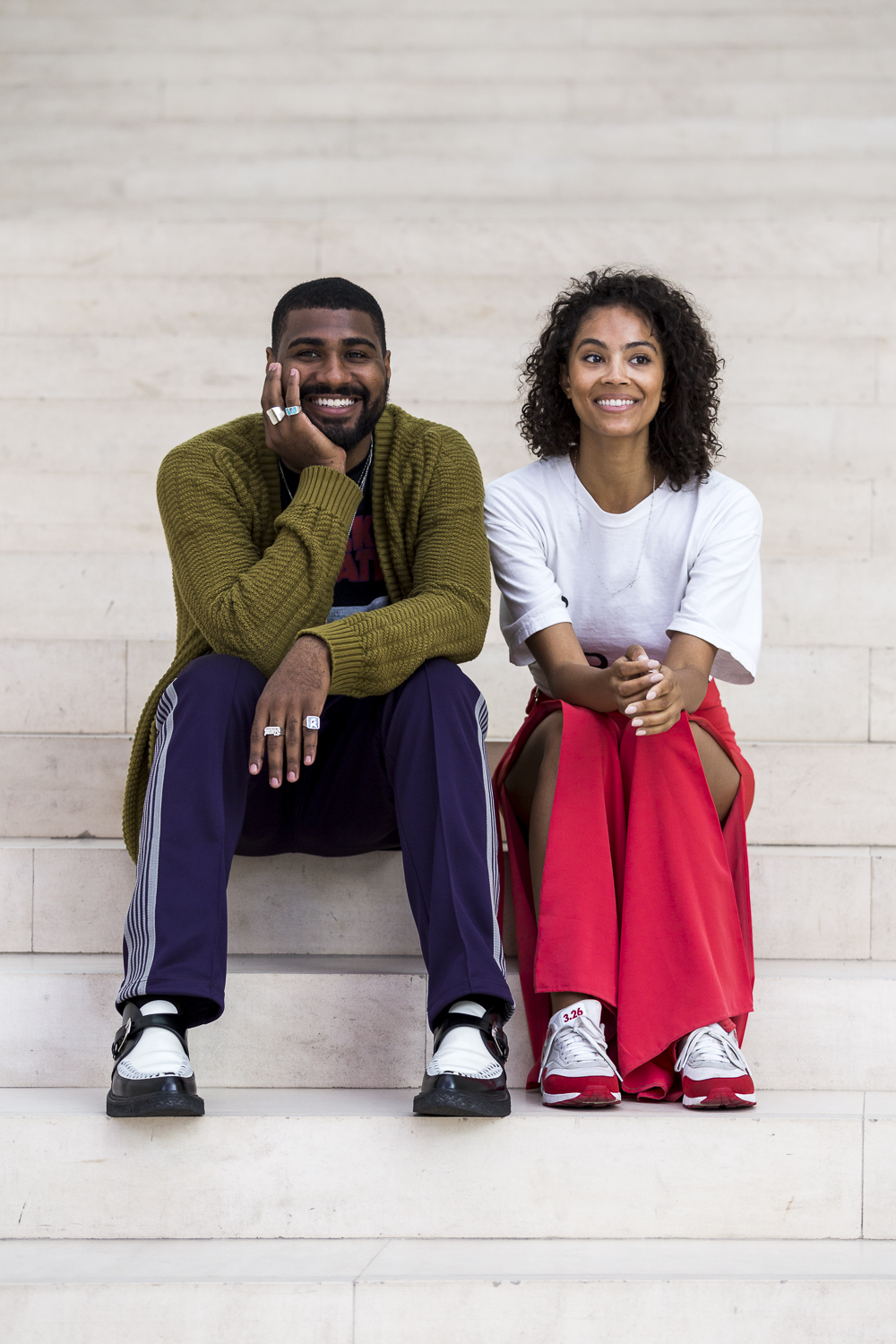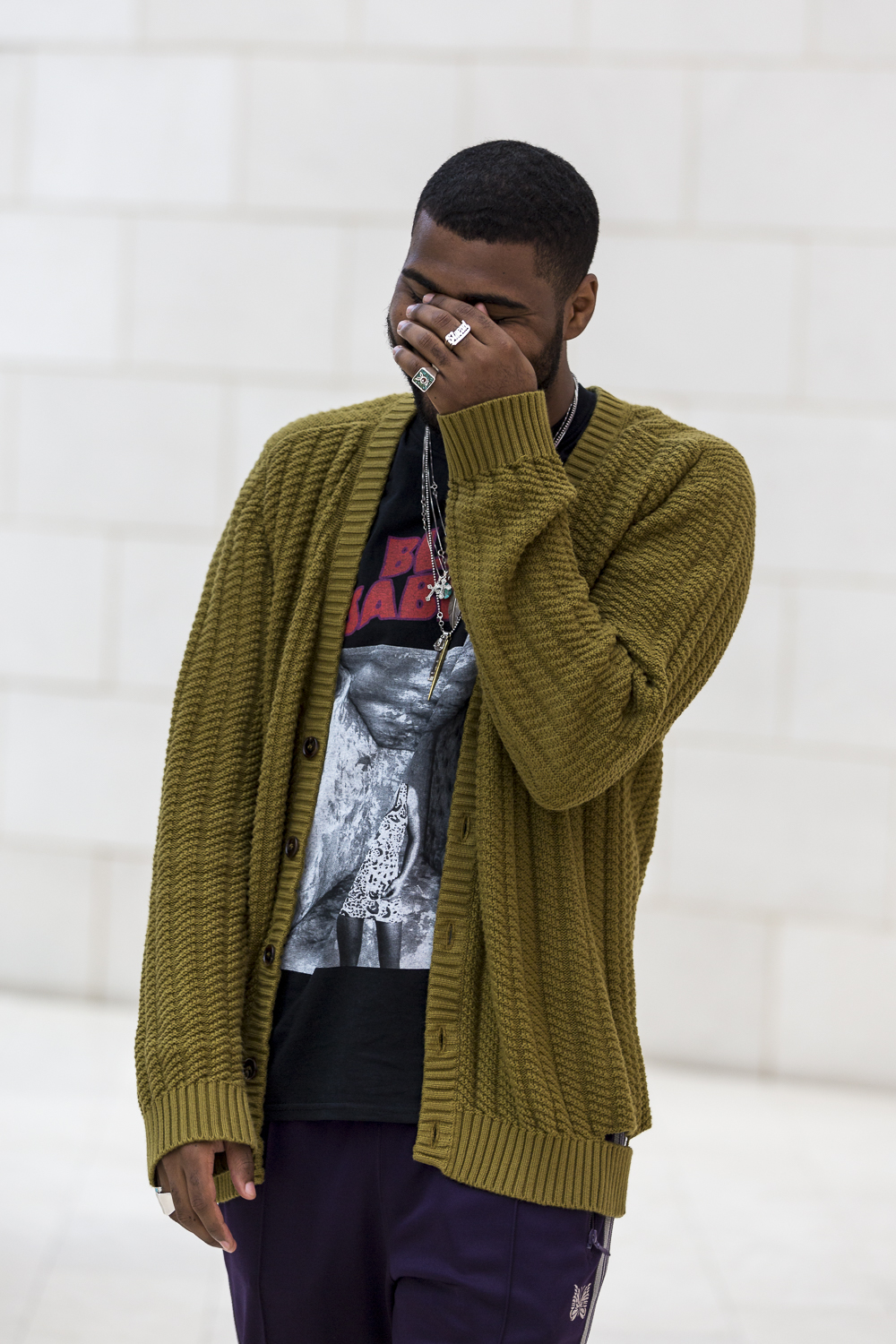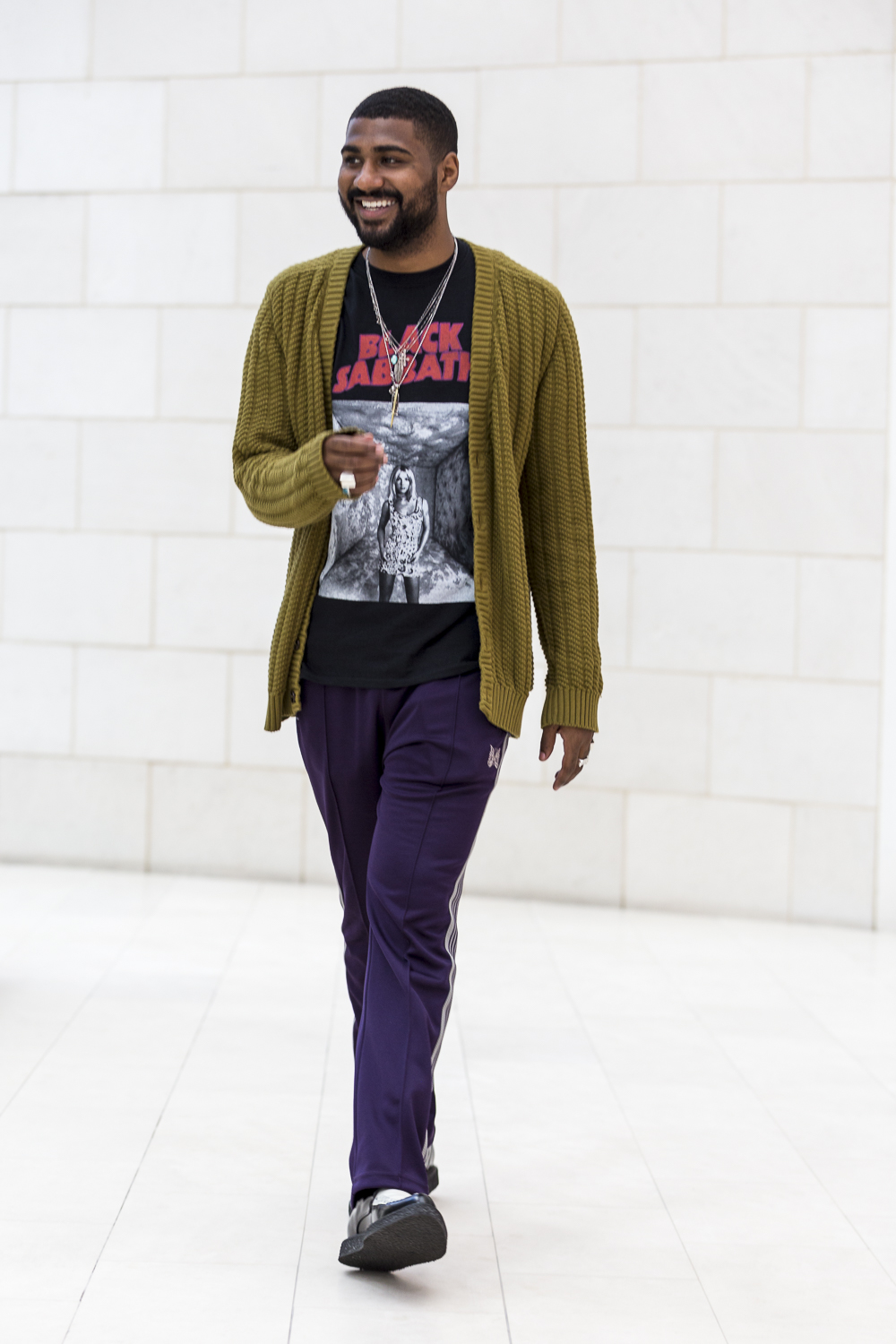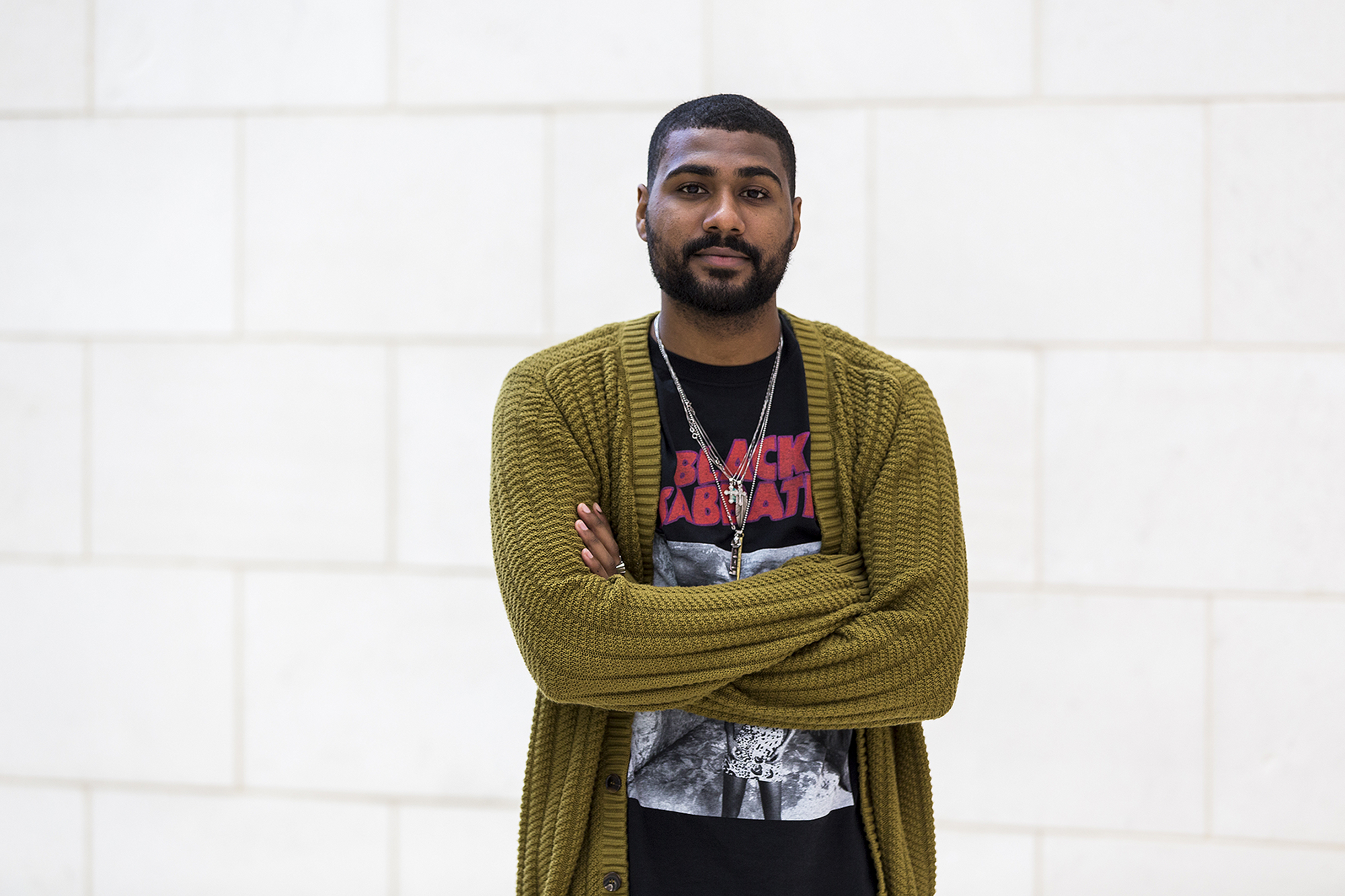The back of CVS isn’t where you would expect to find one of fashion’s leading figures in menswear searching for socks. But there he was, GQ’s Style Editor Mark Anthony Green eyeing which socks to pair with his Saint Laurent creepers. It’s almost euphoric to see one of your idols doing something so ordinary, except he was the furthest thing from ordinary.
Walking closer to the self-checkout, Mark Anthony joked to his girlfriend of over a year, Sinead Bovell, about getting one of the tie-dye, tourist-y dresses sold across the chip aisle. “For the culture,” she said while laughing. And then, seriously for the culture, we discovered Beyonce’s side hustle: perfume.
“Should we do it to them?” Mark Anthony joked. We opted to wait on changing the game by wearing Shimmering Heat.
 We all collectively agreed on going to Collins Quarter for lunch since whatever Australian-accented cuisine was being cooked up smelled phenomenal. But first, there were a few classes at Morris Hall eager to hear from the GQ Style Guy.
We all collectively agreed on going to Collins Quarter for lunch since whatever Australian-accented cuisine was being cooked up smelled phenomenal. But first, there were a few classes at Morris Hall eager to hear from the GQ Style Guy.
Mark Anthony got comfortable and took a seat spending more time answering student’s questions on how he got to GQ, why he minored in Japanese (yes, he’s fluent), and the qualities it takes to succeed than simply talking about himself.
He told the story of how he would send writing clips to someone who worked in GQ’s Public Relations department every two weeks for a year, which he recommends you don’t do. According to Mark Anthony, talent and creativity need to be balanced by hard work and sheer determination. He shared how at the age of 6, little Mark Anthony wrote “editor-and-chief of GQ” as a response to a “what do you want to be when you grow up” assignment.
As the classroom visits wrapped up, Mark Anthony expressed how cool it was to be in an environment where the Dean wore Rick Owens and that he was “blown away” by the space where creativity was nurtured. But the impression he left on us students matched his appreciation for the university. “I didn’t expect him to be so open,” I overheard someone whisper as he exited.
The once unexplainable je ne sais quoi of Mark Anthony Green was then understood. He had this refreshing candor and confidence that was equally as personable as it was infectious, making ordinary sock shopping at CVS seem a lot cooler than it should— and for a second, I even felt like some of his coolness rubbed off on me.
I was intrigued.
Anthony O’Baner: Tell me a little bit about yourself.
Mark Anthony Green: I’m a storyteller. My favorite color is orange. My favorite food is pizza. I spent more money on rings than shoes in 2016. I just celebrated my one year anniversary with my girlfriend. I’ve lived in 9 different cities. I think Rick and Morty is the smartest thing on television. I think Veep is the second smartest thing on television. My favorite writer of all time is James Baldwin. My favorite magazine writer of all time is Devin Friedman. I have scoliosis. I love Georgia and plan on doing some work here, too.
Growing up in Kansas City, how were you introduced to fashion?
Kansas City is not a fashion incubator, as one would believe. I was introduced to style through my father. He’s a stylish guy. He use to have Alan Flusser ‘Dressing the Man: Mastering the Art of Permanent Fashion’ and GQ subscriptions. Television, and then thank god the internet came. You could always tell kids, like myself, who lived in a city where no one around you cared or talked about fashion because we can’t pronounce anything. I wasn’t having a conversation with my friends about Hedi Slimane, so I’m reading it and you just don’t know any better. It’s getting pronounced like…
 Like “He-dee Slim-in?”
Like “He-dee Slim-in?”
Yeah, like He-dee Slim-in. So it’s really cool how the internet has brought people together. I don’t wish I was born any later. I enjoy the generation I came up in, but I definitely think your generation, kids these days, you kids at SCAD that aren’t from a “cool” city have an advantage which is really cool.
So what’s a funny fashion story that you can share?
Awe man… [laughs] There’s plenty. On my first day at GQ, I had gotten nervous. This is a super round-about way of starting the story, but leather doesn’t retain odor, so when you sweat into a pair of dress shoes, or loafers, that are leather, they don’t smell like anything…So I had this pair of hybrid dress shoes that I wore on my first day and I was, like, 90 percent sure they weren’t lined in leather. And it was hot. So I’m like, man, you’re about to kill your shoes, so I put powder in them. But while I was putting baby powder in them, I got distracted talking— you know, I’m in New York. I just remember half-ass doing it. So, I’m walking to work and got all the way to 42nd, got off the subway, and I could tell people were looking at me. But my vanity thought “oh you just look good, oh you just killing it, you’re giving New York all the looks”, right? and then I look down— and that’s how preoccupied I was with the city, that I wouldn’t even look down. I look down and I was smoking. Every time I took a step, the powder would puff out. So it was like I was walking on a cloud.
That’s wild. Did you make it in time to clean up?
I was so geeked. I had to go to the bathroom and wipe my denim clean and wipe the shoes clean, you know. Luckily, I was 2 hours early.
When did you know you wanted to work in fashion?
When I was a little kid, I knew I wanted to work for GQ. I knew that it was going to be a large part of who I am. I think those two are synonymous. But I always cared about how I dressed. I wanted to be best dressed in my high school yearbook more than being valedictorian. That was important to me— and I got it. It’s always been second nature.
How did your experience attending Morehouse College shape you?
Morehouse was the most nurturing, most confrontational 5 years of my life. It was 50 percent pure brotherhood, pure mentorship, pure support and black genius, and reinforcing that the way I sound, the way I talk, the way I carry myself is a good thing that this world needs. And then it was 50 percent competition and do-or-die, and long lines and dropped classes, and evictions and homelessness, and fights and craziness.
I can relate to some of those experiences. It sounds like a few students I know, actually.
There is no better education than the mixture of both of those things. I could not have gotten a better preparation for the world. And I feel like being a black man with a little bit of success is like that. It’s 50 percent love and praise and appreciation for your perspective on the world and then it’s 50 percent obstacle.
You don’t want the fashion industry to use blackness as a trend. So whenever I see only black models on a runway, I roll my eyes a little bit. But that’s because I’m cautious, because blackness isn’t temporary.”
So piggybacking off of that, being black in a predominantly white industry, what were some obstacles you faced, if any?
You know, some were self-inflicted. When I first got to GQ, I knew people’s perception of a GQ Editor was a tall, lean, handsome white dude in a suit— and I wasn’t wrong on this. That was GQ. Like, full head of hair, great teeth, and smile. Like a Princeton looking motherfucker. And I was a young black kid who loved sneakers and Rick Owens, and I wasn’t that. But I also loved suits. I knew that I had to battle through that, so I dressed up every single day. I was the most suited human being in GQ history. And it was to try to bridge that gap of what people expected when I would show up. The more confident I became in myself and the more established I became in this industry, I felt like “Oh, I can wear some Japanese sweats and a pair of sneakers.” And then a million other racist things, like people assume you’re an intern in the middle of the room, or people just not caring about what you care about because it’s something they never knew growing up and vice versa.
That’s true.
I’ll say this. I had never heard of Bruce Springsteen until I got to GQ at the age of 20-whatever. He’s meant nothing to me, right? So that’s one thing. But there are plenty of artists and stories and designers that a lot of people have never heard of because I grew up differently than them and they grew up differently than me. It takes some time to convince people to believe. You have to build your cred. And they’re not doing it intentionally. They just don’t know that they should care about it. Then you also have the overt racist stuff too. It does exist. But I felt like my parents and Morehouse, and all the bad things that got me to that point protected me from going into any situation too naive or too underprepared. I’ve never felt underprepared for anything.
You are one of the few recognizable, prominent men of color in fashion. What are your thoughts on the current climate of diversity and representation of us in the industry?
There are some amazing men and women of color that are holding court right now. Edward [Enninful] is killing it; Elaine [Weltwroth] at Teen Vogue, she’s killing it— she’s brilliant. You have more and more getting their shot. Oliver at Helmut Lang, Olivier [Rousteing] at Balmain. You’re seeing it more and more. But I will say one thing I’m cautious of. You don’t want the fashion industry to use blackness as a trend. So whenever I see only black models on a runway, I roll my eyes a little bit. But that’s because I’m cautious because blackness isn’t temporary. It’s not a flash in the pan. In a lot of fields, genres, sports and artistic disciplines, blackness is the most dominant source of creativity and influence. I’m grateful for the times I’ve been able to be myself, my true self, and for that to be accepted. And I’m excited about us all having the opportunity to do that more in the future because I think things are getting better.
Do you remember your first job or task at GQ?
I remember the first thing I had to write about as an employee. Will Welch asked me to write 200 words on Don C’s “Just Don” snapbacks. They had just started poppin’. I remember him being like, “I’m going to put you in an e-mail with Don,” and how casual he was about it. The way that Don spoke to me, he spoke to me with this instant level of respect— because of GQ, not because of me. And I was like, “Oh O.K., this is how I should carry myself now.” Not that I’m GQ like I’m so big, bad and important, but you should carry yourself in the manner that I represent a thing that’s important. And I need to be honest and I need to be diligent and to be as creative and as forward-looking as possible because this thing that I represent has been that since 1957. And Will Welch, honestly, a lot of my big gigs came from him. That’s my OG. That’s my big brother.
What’s the best part of your job as Style Editor and Style Guy?
It’s ironic. My favorite part of the Style Editor gig is the thing that I grapple with as Style Guy. My favorite part of the Style Editor gig is that it’s always different and I always have a new challenge. I finished our November cover story I wrote, which is different than any story I’ve ever reported and written. With Style Guy, it’s that format, and we’re going to vary it in 2018 which is why I’m super excited, but until then, it just seemed like it was stuck in its ways—it’s stagnant. And that to me is the only thing that’s tough for me. But for me, I value challenges.
 That’s honestly the only way you grow as a creative.
That’s honestly the only way you grow as a creative.
That’s it. That’s the only way you do something cool.
Can you elaborate on what a day in the life is like as Style Editor and the Style Guy of GQ?
I travel a lot. I try to surround myself with creative things and creative people. I don’t have a set schedule. It’s great for me and it’s how I want to live, but I’ve also never been afraid to stay super late and jump on a plane last minute with no bags. I’ve never been afraid to work a weekend, or every weekend, or whatever. I’ve never batted an eye at that. And I think that’s why it works. It’s super fluid and the only thing that determines where I am and what I’m doing is what the magazine needs. What’s the new challenge? And that’s my dream way to live.
You also dabble in art as well too, right?
Yeah, I do.
I was talking to Sinead earlier and she mentioned that you have an upcoming film. Are there any other ventures you are pursuing in art?
The film is the big play. The name of it is “Trapeze.” It’s a 30-minute film, shot on 35mm, about political correctness. The main character is an amazing, black little person. He’s fresh as fuck. All the clothes are great. It’s meant to make people laugh and think together. I can’t wait to show it.
When are you planning on launching it?
We’re doing something in November in New York and we’re going to do some festivals. The goal is to give it to everybody in February.
As you stated earlier before, you are a storyteller. What do you most enjoy about your work? Why is that your passion and when did you know that’s what you wanted to do?
At 6 I knew I wanted to be at GQ, but I didn’t know about the storytelling. I wasn’t that deep of a 6-year-old. [laughs] This is the first time I thought about that. I think the first time I saw someone do that would be my father when he would have people over. It was just how he would hold court. Or when you go to the barbershop, there’s always that super funny guy who would hold court. There’s something about that. It’s not an attention thing ‘cause I’m not crazy about attention for attention’s sake. There’s a level of finesse, creativity, wit, and power that you have to have in order to grab a room like that. You have to have that and then some to grab someone when you’re not in a room, whether that’s through writing, film, painting or whatever. So grabbing people’s attention, making them think and feel something, I can’t think of something better to do with whatever I possess. I’ve thought about it. I’ve looked for it, but there’s nothing more satisfying than to get people to stop and pay attention.
Don’t only be influenced by creatives, be influenced by creators and hustlers.”
Going back to fashion, you are the Style Guy, so I have to ask for some tips. What are some upcoming trends in menswear?
I want to make it specific to college kids. You guys are so cool down here though, so it’s like who am I to tell y’all what to wear or do. You guys should dress up more down here, though. This should be the most stylish campus in America. There’s something here that I’ve never seen at other schools before. That’s not what you asked me, but that’s a mandate that I’m putting on all people who go to SCAD. Everyone here should be on another level, because everything here is considered, and you guys should go for it. They should put clothing allowances for every student.
I completely support the idea of clothing allowances.
Who’s the president of SCAD?
Paula Wallace.
Paula Wallace, you ‘gotta give every student a $1,500 to $2,500 clothing allowance.
Just a little grant.
Yeah, per quarter. A grant, just to get a few fits off. For real.
I’m here for that.
Who is someone who has influenced you and your style the most?
I could answer this question with literally 100 names, but someone who really doesn’t get the credit he deserves is Quincy Jones. I urge everyone to google Young Quincy Jones. He was the most stylish human being on the planet. Quincy was elegant and Parisian. He just had it. But every now and then, I see some people and I’m like, “Okay. You’re the one.” Early Prince, Marvin Gaye, Glenn O’Brien, A$AP Rocky, Andre 3000. I think Pharrell is the most stylish man of all time. Ryan Gosling may be the most stylish actor we’ve seen. Cary Grant was everything. He had the juice. Elvis, a controversial pick, because— well we won’t get into the politics of it, but politics aside, Elvis is top 5.
And what advice could you give young creatives before they get into their respective fields?
You know, I’m always inspired by people like Puff, because part of his brand and mantra is the fact that he works. He doesn’t take no for an answer. You can have the creative part and idea down, but if you match it with that intensity and hustle— that’s Steve Jobs. That’s how you make something that really will affect the world. Don’t only be influenced by creatives, be influenced by creators and hustlers. Don’t allow yourself to be a tortured artist who doesn’t make anything. It’s cool in theory, but push yourself to put that shit out. That’s really important. Things are grim in this world right now and holding in your light isn’t going to make it any better. It’s obligatory to produce things and to share them, whether you share them for a million dollars or for free. You have to start putting shots up.
Photography by Angie Stong

